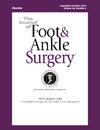Fillet of toe flap coverage for non-traumatic foot amputations: A retrospective review of 70 patients
IF 1.3
4区 医学
Q2 Medicine
引用次数: 0
Abstract
Fillet of toe flap (FTF) leverages the “spare parts” algorithm in reconstructive surgery–utilizing tissue from amputated or otherwise non-salvageable body parts, thus avoiding donor-site morbidity. This study assesses the efficacy of FTF coverage in non-traumatic foot amputations. A retrospective review of patients undergoing foot amputation with FTF coverage between January 2013 to August 2023 was conducted. Patient characteristics, operative details, and outcomes were collected. Primary outcome was FTF survival (no necrosis ≤7 days postoperatively). Secondary outcome was acute complications (≤42 days postoperatively). A total of 70 patients were included. Mean age was 65.0±13.7 years. Median Charlson Comorbidity Index was 6.0 (interquartile range [IQR]: 4.0-7.0). The most common wound location was the hallux (n=34). In 45 (64.2 %) patients with preoperative angiography, the patency rates were: first dorsal metatarsal artery (n=10, 22.2 %), lateral plantar artery (n=7, 15.6 %), medial plantar artery (n=6, 13.3 %), and dorsalis pedis artery (n=4, 8.9 %). Mean follow-up duration was 9.0 (IQR: 32) months. Fifteen (21.4 %) patients experienced at least one acute complication: deep surgical site infection (SSI; i.e., abscess, gangrenous necrosis; n=13, 18.6 %) and cellulitis (n=7, 10.0 %). Eleven (15.7 %) patients required reoperation for debridement (n=4, 5.7 %), wound closure (n=4, 5.7 %), flap necrosis (n=3, 4.3 %), incision and drainage (n=1, 1.4 %), split-thickness skin grafting (n=1, 1.4 %), and foreign body exploration (n=1, 1.4 %). FTF survival was 94.2 % (n=66). FTF facilitates reconstruction in complex cases and should be integrated into each chronic LE wound algorithm to avoid additional donor-site morbidity, and to facilitate stump-length preservation or limb salvage.
非创伤性足截肢的趾蹼覆盖:70 例患者的回顾性研究
足趾腓骨瓣(FTF)利用了整形手术中的 "备件 "算法--利用截肢或其他无法修复的身体部位的组织,从而避免了供体部位的发病率。本研究评估了 FTF 覆盖在非创伤性足部截肢中的疗效。研究人员对2013年1月至2023年8月期间接受FTF覆盖的足部截肢患者进行了回顾性研究。收集了患者特征、手术细节和结果。主要结果是FTF存活率(术后7天内无坏死)。次要结果是急性并发症(术后≤42天)。共纳入 70 名患者。平均年龄(65.0±13.7)岁。Charlson 生病指数中位数为 6.0(四分位数间距 [IQR]:4.0-7.0)。最常见的伤口位置是拇指(34 人)。45例(64.2%)患者术前进行了血管造影,其通畅率分别为:第一跖背动脉(10例,22.2%)、足外侧动脉(7例,15.6%)、足内侧动脉(6例,13.3%)和足背动脉(4例,8.9%)。平均随访时间为 9.0 个月(IQR:32)。15例(21.4%)患者至少出现了一种急性并发症:深部手术部位感染(SSI;即脓肿、坏疽坏死;13例,18.6%)和蜂窝组织炎(7例,10.0%)。11例(15.7%)患者需要再次手术,包括清创(4例,5.7%)、伤口闭合(4例,5.7%)、皮瓣坏死(3例,4.3%)、切开引流(1例,1.4%)、裂厚植皮(1例,1.4%)和异物探查(1例,1.4%)。FTF存活率为94.2%(n=66)。FTF有助于复杂病例的重建,应纳入每种慢性LE伤口算法中,以避免额外的供体部位发病率,并促进残肢长度的保留或肢体的挽救。
本文章由计算机程序翻译,如有差异,请以英文原文为准。
求助全文
约1分钟内获得全文
求助全文
来源期刊

Journal of Foot & Ankle Surgery
ORTHOPEDICS-SURGERY
CiteScore
2.30
自引率
7.70%
发文量
234
审稿时长
29.8 weeks
期刊介绍:
The Journal of Foot & Ankle Surgery is the leading source for original, clinically-focused articles on the surgical and medical management of the foot and ankle. Each bi-monthly, peer-reviewed issue addresses relevant topics to the profession, such as: adult reconstruction of the forefoot; adult reconstruction of the hindfoot and ankle; diabetes; medicine/rheumatology; pediatrics; research; sports medicine; trauma; and tumors.
 求助内容:
求助内容: 应助结果提醒方式:
应助结果提醒方式:


